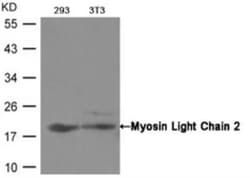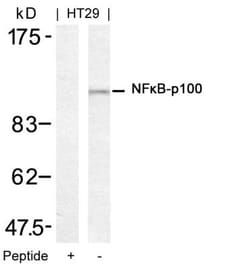LIM kinase 2, p Thr505 Antibody, Novus Biologicals™
Manufacturer: Fischer Scientific
Select a Size
| Pack Size | SKU | Availability | Price |
|---|---|---|---|
| Each of 1 | NB017859-Each-of-1 | In Stock | ₹ 23,852.00 |
NB017859 - Each of 1
In Stock
Quantity
1
Base Price: ₹ 23,852.00
GST (18%): ₹ 4,293.36
Total Price: ₹ 28,145.36
Antigen
LIM kinase 2 (p Thr505)
Classification
Polyclonal
Conjugate
Unconjugated
Formulation
phosphate buffered saline (without Mg2+ and Ca2+), pH 7.4, 150mM NaCl, and 50% glycerol. with 0.02% Sodium Azide
Gene Alias
EC 2.7.11.1, LIM domain kinase 2, LIMK-2
Host Species
Rabbit
Molecular Weight of Antigen
70 kDa
Quantity
0.025 mL
Research Discipline
Phospho Specific, Protein Kinase
Gene ID (Entrez)
3985
Target Species
Rat, Human, Mouse
Isotype
IgG
Applications
Immunocytochemistry, Immunohistochemistry (Paraffin), Immunohistochemistry, Western Blot, Immunofluorescence
Concentration
1.0 mg/mL
Dilution
Western Blot 1:500-1:1000, Immunohistochemistry 1:50-1:100, Immunocytochemistry/Immunofluorescence 1:100-1:200, Immunohistochemistry-Paraffin 1:50-1:100
Gene Accession No.
P53671
Gene Symbols
LIMK2
Immunogen
The antiserum was produced against synthesized phosphopeptide derived from human LIMK2 around the phosphorylation site of threonine 505 (R-Y-TP-V-V).
Purification Method
Affinity Purified
Regulatory Status
RUO
Primary or Secondary
Primary
Test Specificity
LIMK2 (specific to Phospho-Thr505) detects endogenous levels of LIMK2 only when phosphorylated at threonine 505.
Content And Storage
Store at 4C short term. Aliquot and store at -20C long term. Avoid freeze-thaw cycles.
Description
- LIM kinase 2 Polyclonal specifically detects LIM kinase 2 in Human, Mouse, Rat samples
- It is validated for Western Blot, Immunohistochemistry, Immunocytochemistry/Immunofluorescence, Immunohistochemistry-Paraffin.



